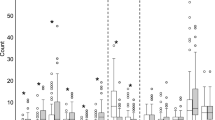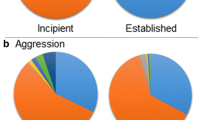Abstract
Social cooperation requires increased tolerance of other individuals. We used social and solitary individuals of the facultatively eusocial bee Megalopta genalis to compare interactions with non-nestmate individuals in a standardized behavioral assay, a circle tube. We set up interactions between bees from different nests matched for caste (solitary, social: queen or worker). We found more tolerance in social than solitary pairs, but found no difference in aggression. We also found that workers continued expressing caste-typical behavior even when matched against other workers from different nests. However, there was no difference in expression of queen-typical behaviors between the three groups. Our data on social caste show that outside of the queen–worker social context, both queens and workers express similar levels of queen-like behavior. However, workers still express higher levels of worker-like behavior than do queens. We found no effect of variation in ovary size on behavior. We found that body size correlated positively with queen-like behaviors, and negatively with worker-like behaviors. Our body size data suggest that the worker phenotype may result from naturally occurring size-correlated variation in behavior, combined with maternal manipulation of both body size through nutrition and behavior and ovary development through social aggression.




Similar content being viewed by others
References
Arneson L, Wcislo WT (2003) Dominant-subordinate relationships in a facultatively social, nocturnal bee, Megalopta genalis (Hymenoptera: Halictidae). J Kans Entomol Soc:183–193
Bell WJ (1974) Recognition of resident and non-resident individuals in intraspecific nest defense of a primitively eusocial halictine bee. J Comp Physiol A 93:195–202
Breed MD (2014) Kin and nestmate recognition: the influence of WD Hamilton on 50 years of research. Anim Behav 92:271–279
Breed MD, Silverman JM, Bell WJ (1978) Agonistic behavior, social interactions, and behavioral specialization in a primitively eusocial bee. Insectes Soc 25:351–364
Brockmann HJ, Dawkins R (1979) Joint nesting in a digger wasp as an evolutionarily stable preadaptation to social life. Behaviour 71:203–244
Buckle G (1982) Differentiation of queens and nestmate interactions of newly established colonies of Lasioglossum zephyrum (Hymenoptera: Halictidae). Sociobiology 7:8–20
Dew RM, Gardner MG, Schwarz MP (2014) The problems of a priori categorisation of agonism and cooperation: circle-tube interactions in two allodapine bees. Ethology 120:551–562
Flores-Prado L, Aguilera-Olivares D, Niemeyer HM (2008) Nest-mate recognition in Manuelia postica (Apidae: Xylocopinae): an eusocial trait is present in a solitary bee. Proc Biol Sci 275:285–291. U645387280H3Q305
Gibbs J, Brady SG, Kanda K, Danforth BN (2012) Phylogeny of halictine bees supports a shared origin of eusociality for Halictus and Lasioglossum (Apoidea: Anthophila: Halictidae). Mol Phylogenet Evol 65:926–939
Gonzalez V, Patton R, Plascencia M, Girişgin A, Çakmak I, Barthell J (2018) High levels of tolerance between nestmates and non-nestmates in the primitively eusocial sweat bee Halictus scabiosae (Rossi) in Turkey (Hymenoptera: Halictidae). Insectes Soc 65:339–343
Jeanson R, Kukuk PF, Fewell JH (2005) Emergence of division of labour in halictine bees: contributions of social interactions and behavioural variance. Anim Behav 70:1183–1193
Kapheim KM (2017) Nutritional, endocrine, and social influences on reproductive physiology at the origins of social behavior. Curr Opin Insect Sci 22:62–70
Kapheim KM, Chan T, Smith A, Wcislo WT, Nonacs P (2016) Ontogeny of division of labor in a facultatively eusocial sweat bee Megalopta genalis. Insectes Soc 63:185–191
Kapheim KM, Smith AR, Nonacs P, Wcislo WT, Wayne RK (2013) Foundress polyphenism and the origins of eusociality in a facultatively eusocial sweat bee, Megalopta genalis (Halictidae). Behav Ecol Sociobiol 67:331–340
Kapheim KM, Bernal SP, Smith AR, Nonacs P, Wcislo WT (2011) Support for maternal manipulation of developmental nutrition in a facultatively eusocial bee, Megalopta genalis(Halictidae). Behav Ecol Sociobiol 65:1179–1190
Kapheim KM, Nonacs P, Smith AR, Wayne RK, Wcislo WT (2015) Kinship, parental manipulation and evolutionary origins of eusociality. Proc Biol Sci 282:20142886. https://doi.org/10.1098/rspb.2014.2886 [doi]
Kapheim KM, Smith AR, Ihle KE, Amdam GV, Nonacs P, Wcislo WT (2012) Physiological variation as a mechanism for developmental caste-biasing in a facultatively eusocial sweat bee. Proc Biol Sci 279:1437–1446. https://doi.org/10.1098/rspb.2011.1652
Kelber A, Warrant EJ, Pfaff M, Wallén R, Theobald JC, Wcislo WT, Raguso RA (2006) Light intensity limits foraging activity in nocturnal and crepuscular bees. Behav Ecol 17:63–72
Kocher SD, Paxton RJ (2014) Comparative methods offer powerful insights into social evolution in bees. Apidologie 45:289–305
Lawson SP, Helmreich SL, Rehan SM (2017) Effects of nutritional deprivation on development and behavior in the subsocial bee Ceratina calcarata (Hymenoptera: Xylocopinae). J Exp Biol 220:4456–4462. https://doi.org/10.1242/jeb.160531 [doi]
Lin N, Michener CD (1972) Evolution of sociality in insects. Q Rev Biol 47:131–159
McConnell-Garner J, Kukuk PF (1997) Behavioral interactions of two solitary, halictine bees with comparisons among solitary, communal and eusocial species. Ethology 103:19–32
Michener C, Brothers D (1974) Were workers of eusocial hymenoptera initially altruistic or oppressed. Proc Natl Acad Sci USA 71:671–674. https://doi.org/10.1073/pnas.71.3.671
Michener CD (1990) Reproduction and castes in social halictine bees. In: Engels W (ed) Social insects. Springer, Berlin, pp 77–121
Michener CD (1974) The social behavior of the bees: a comparative study. Harvard University Press, Cambridge
Packer L (2006) Use of artificial arenas to predict the social organisation of halictine bees: data for fourteen species from Chile. Insectes Soc 53:307–315
Packer L (2005) The influence of marking upon bee behaviour in circle tube experiments with a methodological comparison among studies. Insectes Soc 52:139–146
Peso M, Richards MH (2010) Knowing who’s who: nestmate recognition in the facultatively social carpenter bee, Xylocopa virginica. Anim Behav 79:563–570
Pabalan N, Davey K, Packer L (2000) Escalation of aggressive interactions during staged encounters in Halictus ligatus Say (Hymenoptera: Halictidae), with a comparison of circle tube behaviors with other halictine species. J Insect Behav 13:627–650
Plateaux-Quénu C (2008) Subsociality in halictine bees. Insectes Soc 55:335–346
Polidori C, Borruso L (2012) Socially peaceful: foragers of the eusocial bee Lasioglossum malachurum are not aggressive against non-nestmates in circle-tube arenas. acta ethol 15:15–23. https://doi.org/10.1007/s10211-011-0103-z
Reeve HK (1989) The evolution of conspecific acceptance thresholds. Am Nat 133:407–435
Rehan SM, Richards MH (2013) Reproductive aggression and nestmate recognition in a subsocial bee. Anim Behav 85:733–741
Richards MH, Packer L (2010) Social behaviours in solitary bees: interactions among individuals in Xeralictus bicuspidariae Snelling (Hymenoptera: Halictidae: Rophitinae). J Hym Res 19:66–76
Schwarz MP, Richards MH, Danforth BN (2007) Changing paradigms in insect social evolution: insights from halictine and allodapine bees. Annu Rev Entomol 52:127–150
Shell WA, Rehan SM (2017) Behavioral and genetic mechanisms of social evolution: insights from incipiently and facultatively social bees. Apidologie 49:1–18
Sherman PW, Reeve HK, Pfennig DW (2009) Recognition systems. In: Krebs JR, Davies NB (eds) Behavioural ecology: an evolutionary approach, 4th edn. Blackwell Publishing, Malden, pp 69–96
Smith AR, Kitchen SM, Toney RM, Ziegler C (2017) Is nocturnal foraging in a tropical bee an escape from interference competition? J Insect Sci. https://doi.org/10.1093/jisesa/iex030
Smith AR, Kapheim KM, Pérez-Ortega B, Brent CS, Wcislo WT (2013) Juvenile hormone levels reflect social opportunities in the facultatively eusocial sweat bee Megalopta genalis (Hymenoptera: Halictidae). Horm Behav 63:1–4
Smith AR, Kapheim KM, O’Donnell S, Wcislo WT (2009) Social competition but not subfertility leads to a division of labour in the facultatively social sweat bee Megalopta genalis (Hymenoptera: Halictidae). Anim Behav 78:1043–1050
Smith AR, Wcislo WT, O’Donnell S (2008) Body size shapes caste expression, and cleptoparasitism reduces body size in the facultatively eusocial bees Megalopta (Hymenoptera: Halictidae). J Insect Behav 21:394–406
Smith AR, Wcislo WT, O’Donnell S (2003) Assured fitness returns favor sociality in a mass-provisioning sweat bee, Megalopta genalis (Hymenoptera: Halictidae). Behav Ecol Sociobiol 54:14–21
Smith BH, Weller C (1989) Social competition among gynes in halictine bees: the influence of bee size and pheromones on behavior. J Insect Behav 2:397–411
Wcislo WT, Arneson L, Roesch K, Gonzalez V, Smith A, Fernández H (2004) The evolution of nocturnal behaviour in sweat bees. Megalopta genalis and M. ecuadoria (Hymenoptera: Halictidae): an escape from competitors and enemies?. Biol J Linn Soc 83:377–387
Hymenoptera (1997) Social interactions and behavioral context in a largely solitary bee, Lasioglossum (Dialictus) figueresi. (Hymenoptera, Halictidae). Insectes Soc 44:199–208
West-Eberhard MJ (1996) Wasp societies as microcosms for the study of development and evolution. In: West-Eberhard MJ, Turillazzi S (eds) Natural history and evolution of paper wasps. Oxford University Press, Oxford, pp 290–317
West-Eberhard MJ (1987) Flexible strategy and social evolution. In: Ito Y, Brown L, Kikkawa L (eds) Animal societies: theories and facts. Japan Scientific Societies, Tokyo, pp 35–51
Wilson EO (1971) The insect societies. Harvard University Press, Cambridge
Acknowledgements
This work was supported by NSF Grant #17-1028536545 to ARS and MAS. Yi Ling and Callum Kingwell helped collect nests.
Author information
Authors and Affiliations
Corresponding author
Rights and permissions
About this article
Cite this article
Smith, A., Simons, M., Bazarko, V. et al. The influence of sociality, caste, and size on behavior in a facultatively eusocial bee. Insect. Soc. 66, 153–163 (2019). https://doi.org/10.1007/s00040-018-00679-4
Received:
Revised:
Accepted:
Published:
Issue Date:
DOI: https://doi.org/10.1007/s00040-018-00679-4




